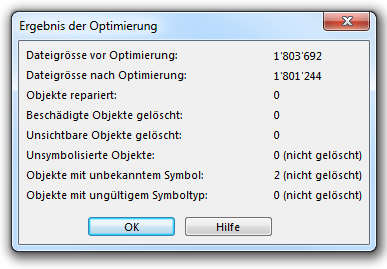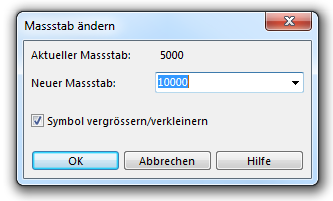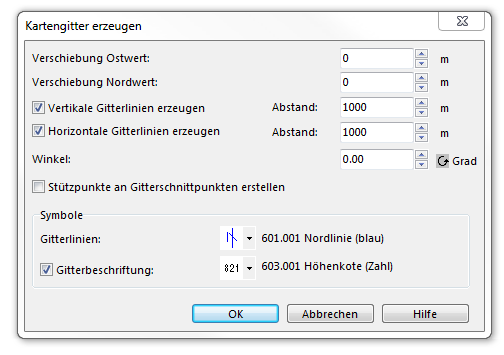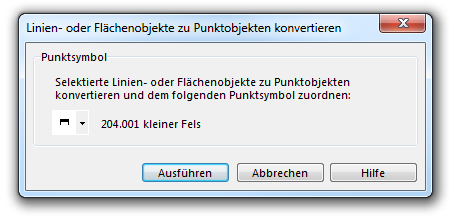Karte: Unterschied zwischen den Versionen
JBO (Diskussion | Beiträge) |
JBO (Diskussion | Beiträge) |
||
| Zeile 101: | Zeile 101: | ||
==Textobjekte in Punktobjekte umwandeln [[File:Space.PNG]][[File:Pro40px.PNG|This function is available in OCAD 11 Professional.|link=https://www.ocad.com/en/products/ocad-for-cartography]]== | ==Textobjekte in Punktobjekte umwandeln [[File:Space.PNG]][[File:Pro40px.PNG|This function is available in OCAD 11 Professional.|link=https://www.ocad.com/en/products/ocad-for-cartography]]== | ||
Choose this command from the '''Map''' menu to convert text to point objects. The '''Convert Text Objects to Point Objects''' dialog appears. | Choose this command from the '''Map''' menu to convert text to point objects. The '''Convert Text Objects to Point Objects''' dialog appears. | ||
This function is used after import map drawn in DTP program. In a DTP program point symbols are often drawn with a character and a special symbol fonts. OCAD can convert this characters to a point symbol. | |||
In the first part of the dialog you can decide wheter you want to convert the objects from all text symbols or only objects from a selected symbol. | In the first part of the dialog you can decide wheter you want to convert the objects from all text symbols or only objects from a selected symbol. | ||
| Zeile 106: | Zeile 108: | ||
In the second part of the dialog box you can create a list of references. A reference consists of a layer and the corresponding OCAD symbol. You can save the list to a cross reference (.crt) file for later use. You can load an existing cross reference file to modify or execute it. | In the second part of the dialog box you can create a list of references. A reference consists of a layer and the corresponding OCAD symbol. You can save the list to a cross reference (.crt) file for later use. You can load an existing cross reference file to modify or execute it. | ||
Visit the '''[[ | Visit the '''[[Cross Reference Table]]''' page to get some information about CRT-Files and the CRT-File part in the dialog. | ||
Example of crt file: | |||
312.000 A | |||
313.000 B | |||
314.000 C | |||
The same data in the dialog: | |||
[[File:ConvertTextObjectsToPointObjects.PNG]] | |||
Click the '''Execute''' button when you are finished with editing the '''[[Cross Reference Table|CRT- | Click the '''Execute''' button when you are finished with editing the '''[[Cross Reference Table|CRT-File]]'''. The conversion gets executed. | ||
==Textobjekte von OEM nach Unicode konvertieren [[File:Space.PNG]][[File:Pro40px.PNG|This function is available in OCAD 11 Professional.|link=https://www.ocad.com/en/products/ocad-for-cartography]]== | ==Textobjekte von OEM nach Unicode konvertieren [[File:Space.PNG]][[File:Pro40px.PNG|This function is available in OCAD 11 Professional.|link=https://www.ocad.com/en/products/ocad-for-cartography]]== | ||
Version vom 13. August 2013, 08:18 Uhr
Optimieren reparieren 





Wählen Sie diese Funktion im Menü Karte um die Dateigrösse zu optimieren und beschädigte Objekte zu reparieren. Beim Bearbeiten der Karte wie zum Beispiel dem Löschen von Objekten werden Lerrräume in der Datei erzeugt. Diese Funktion entfernt diese Leerräume und reduziert damit die Dateigrösse.
Wenn OCAD beschädigte Objekte findet versucht das Programm diese zu reparieren. Falls dies nicht möglich ist, werden die betroffenen Objekte gelöscht.
Nach der Optimierung wird der Dialog Ergebnis der Optimierung angezeigt. Er enthält folgende Informationen:
- Dateigrösse vor Optimierung in bytes.
- Dateigrösse nach Optimierung in bytes.
- Objekte repariert
- Beschädigte Objekte gelöscht
- Unsichtbare Objekte deleted: Unsichtbare Objekte sind nicht sichtbar. Das können beispielsweise Textobjekte ohne Text und Linie, Linienobjekte mit nur einem Stützpunkt oder Flächenobjekte mit nur zwei Stützpunkten sein.
- Unsymbolisierte Objekte
- Objekte mit unbekanntem Symbol
- Objekte mit ungültigem Symboltyp
Massstab und Koordinatensystem 




Mehr Informationen zu dieser Funktion finden Sie auf der Seite Eine neue Karte erstellen unter Massstab und Koordinatensystem.
Massstab ändern 




Choose this command in the Map menu to change the scale of the map. The map is enlarged/reduced according to the new scale. The Change Scale dialog box is displayed, where the new scale can be entered.
Actual scale
This line shows the current scale of the map. Choose the Massstab und Koordinatensystem command from the Map menu to set the current scale.
![]() Setting the current scale with the Massstab und Koordinatensystem function does not enlarge or reduce the map. It only changes a number in the map file.
Setting the current scale with the Massstab und Koordinatensystem function does not enlarge or reduce the map. It only changes a number in the map file.
New scale
Enter here the desired new scale of the map. You may choose one of the predefined scales or enter the scale on the keyboard.
Enlarge/reduce symbols
Check this box to enlarge/reduce the symbols with the same factor as the map. When the box is checked, the map is enlarged/reduced like a photographic enlargement. When this box is not checked, the map is enlarged/reduced, but the symbols are kept in the same dimension.
Click the OK button to finish.
Kartengitter erzeugen 



Choose this command from the Map menu to create grid lines on the map (e.g. it can be used to draw Magnetic North lines or the grid for a Namensverzeichnis.). The Create Map Grid dialog box is displayed.
Now, you have to make the following adjustments:
- Easting offset: Enter the easting offset to the defined map grid for the vertical grid lines.
- Northing offset: Enter the northing offset to the defined map grid for the horizontal grid lines.
- Easting distance: Enter the distance between the vertical grid lines.
- Northing distance: Enter the distance between the horizontal grid lines.
- Angle: You can rotate the map grid by an angle entered here.
- Create easting grid lines: Check this option to create easting grid lines.
- Create northing grid lines: Check this option to create northing grid lines.
- Create vertices at grid junctions: Check this option to create a vertex at every grid junction.
- Symbols:
- Graticule lines: Select a line symbol for graticule lines (map grid).
- Gratucule labels: Select a text symbol for graticule labels.
Click the OK button when finished. The grid is drawn over the whole map. Therefore, remove background maps which are larger than the map before creating a grid.
![]() Namensverzeichnis erstellen is the corresponding function to create a name index based on a rectangular map grid.
Namensverzeichnis erstellen is the corresponding function to create a name index based on a rectangular map grid.
WGS84-Gitter erzeugen 

Read more about this topic on the WGS84-Gitter erzeugen page.
Karte verbergen 



Choose this command in the Map menu to hide the map on the screen.
Transformieren
Information about the transforming functions, which are Move, Stretch/Shrink, Mirror, Rotate Map, Change Coordinate System, Affine, Rubbersheeting and Center Map to Drawing Area, can be found on the Karte transformieren page.
Importierte Ebenen in Symbole umwandeln 



Wählen Sie diese Funktion aus dem Menü Karte um die Ebenen aus importierten DXF-, AI- oder Shape-Dateien in Symbole umzuwandeln. Der Dialog Importierte Ebenen in Symbole umwandeln wird angezeigt.
In diesem Dialog können Sie eine Zuordnungstabelle erstellen. Dabei wird zeilenweise die importierte Ebene und das zugehörige OCAD-Symbol aufgelistet. Sie können die Liste als cross reference table (*.crt-Datei) für die spätere Verwendung speichern. Sie können auch eine bereits vorhandende crt-Datei laden und diese bearbeiten oder direkt ausführen.
Klicken Sie auf die Schaltfläche Ausführen wenn die Bearbeitung der Liste abgeschlossen ist und die Symbole zugeordnet werden sollen.
![]() Mehr Informationen über crt-Dateien finden Sie auf der Seite Übersetzungstabelle.
Mehr Informationen über crt-Dateien finden Sie auf der Seite Übersetzungstabelle.
![]() CRT-Dateien können nicht verwendet werden um bei importierten OCAD-Dateien die Symbole zuzuordnen. Importierte Ebenen können manuell zugewiesen werden. Mehr Informationen dazu auf der Seite Ebenen manuell übersetzen.
CRT-Dateien können nicht verwendet werden um bei importierten OCAD-Dateien die Symbole zuzuordnen. Importierte Ebenen können manuell zugewiesen werden. Mehr Informationen dazu auf der Seite Ebenen manuell übersetzen.
Linien- oder Flächenobjekte zu Punktobjekten konvertieren 

Choose this function in the Map menu to convert area or line objects to point objects. This command is enabled if an area or line symbol is selected.
- Select a line or an area object.
- The Convert Area or Line Objects to Point Objects dialog appears.
- Choose a point symbol.
- Click the Execute button. The selected area or line symbol is converted to a point symbol and the chosen symbol is assigned to it.
![]() The point symbol appears in the middle of the area or the line.
The point symbol appears in the middle of the area or the line.
Textobjekte in Punktobjekte umwandeln 

Choose this command from the Map menu to convert text to point objects. The Convert Text Objects to Point Objects dialog appears.
This function is used after import map drawn in DTP program. In a DTP program point symbols are often drawn with a character and a special symbol fonts. OCAD can convert this characters to a point symbol.
In the first part of the dialog you can decide wheter you want to convert the objects from all text symbols or only objects from a selected symbol.
In the second part of the dialog box you can create a list of references. A reference consists of a layer and the corresponding OCAD symbol. You can save the list to a cross reference (.crt) file for later use. You can load an existing cross reference file to modify or execute it.
Visit the Cross Reference Table page to get some information about CRT-Files and the CRT-File part in the dialog.
Example of crt file:
312.000 A 313.000 B 314.000 C
The same data in the dialog:
Click the Execute button when you are finished with editing the CRT-File. The conversion gets executed.
Textobjekte von OEM nach Unicode konvertieren 

Choose this command from the Map menu to convert text objects from OEM to Unicode.
This function can be used after importing geodata from non-Unicode compatible programs or open ocd files from older OCAD versions. OCAD 11 is Unicode compatible.
In the first part of the dialog you can decide wheter you want to convert the text from all text symbols or only objects from a selected symbol.
In the second part of the dialog box you can create a list of references. A reference consists of a layer and the corresponding OCAD symbol. You can save the list to a cross reference (.crt) file for later use. You can load an existing cross reference file to modify or execute it.
Visit the Übersetzungstabelle page to get some information about CRT-Files and the CRT-File part in the dialog.
Click the Execute button when you are finished with editing the CRT-Datei. The conversion gets executed.
Example: After opening OCAD 7 file in OCAD 11 file some characters are invisible (e.g. the character Ť from codepage Windows-1250 to represent texts in Central European and Eastern European languages). Use this function to convert this character from OEM code '141' to the Unicode '356'.
Objekte nach selektierten Symbolen exportieren 



With this function you can export objects with the selected symbol(s) in a new OCAD-Map. Select the desired symbol(s) before choosing this function (e.g. you can export all roads).
Choose this function from the Map menu. The Export Objects by Selected Symbols dialog opens. Browse a location and enter a name for the new file. Then, click the Save button to finish.
Selektierte Objekte exportieren 


With this function you can export the selected object(s) in a new OCAD-Map. Select the desired object(s) before choosing this function.
Choose this function from the Map menu. The Export Selected Objects dialog opens. Browse a location and enter a name for the new file. Then, click the Save button to finish.
Objekte nach selektierten Symbolen löschen 

Choose Delete Objects by Selected Symbols in the Map menu to select all objects with certain symbols or in a certain layer. As an example you can select all roads. The Delete Objects by Selected Symbols dialog box appears.
Alle Objekte mit einem selektierten Symbol
Choose this option and click on the OK button to delete all objects with the selected symbol(s). Select the symbol(s) before you choose the Delete Objects by Selected Symbols command.
Alle Objekte in Ebene
If you import files like PDF, DXF, Adobe Illustrator or OpenStreetMap with layer information, the layer information does not get lost, though OCAD does not support layers as they are known in Adobe Illustrator or similar applications. Choose the All objects in a layer option to delete all objects which are in the same layer. Choose a layer in the dropdown list.
Unsymbolisierte Objekte
Choose this option and click on the OK button to delete all Unsymbolisierte Objekte.
Objekte mit unbekanntem Symbol
Choose this option and click on the OK button to delete all Objekte mit unbekanntem Symbol.
Objekte mit ungültigem Symboltyp
Choose this option and click on the OK button to delete all Objekte mit ungültigem Symboltyp.
Grafikobjekte
Choose this option and click on the OK button to delete all Grafikobjekte.
Bildobjekte
Choose this option and click on the OK button to delete all Bildobjekte.
Kartenausschnitt exportieren 


With this function you can export a part of the current map in a new OCAD-Map.
Choose this function from the Map menu. The Export Part of Map dialog opens on the right side of the screen. The following adjustments can be made:
Boundaries
- Rectangular boundaries: Choose this option to export a rectangular part of the map. You can modify or move the boundaries using the mouse.
- Click
Setup button to define the region to be exported with coordinates. The Setup Part of Map (Export) dialog box appears.
- Click the
Entire Map button to export the entire map. The boundary rectangle adjusts to the entire map.
- Click the
To Current View button to export the map which is currently displayed on the screen. The boundary rectangle adjusts to the current view.
- Use selected object for boundaries: Choose this option to export an irregularly shaped part of the map. Before choosing the Export Part of Map command, you must draw the shape with a line or area object.
- Export with selected object: If you check this option the object which defines the boundary is exported as well.
 To make this function faster convert this cutting object from a curve to a polyline (In Polylinie umwandeln).
To make this function faster convert this cutting object from a curve to a polyline (In Polylinie umwandeln).
- Export database links: This option is checked by default. If you do not want to export the database links, then uncheck this option. This will speed up the export significantally if the map has a lot of linked objects.
Click the OK button when finished. The Export Part of Map dialog opens. Browse a location and enter a name for the new file. Then, click the Save button to finish.
Farben 





You can find all information about colors on the Farben page.
Echtfarben definieren 





Visit the Echtfarben definieren page to get some information about this function.
Farben laden von 




Information about this function can be found on the Farben page.
Farben und Symbole laden von 


Information about this function can be found on the Farben page.
Symbole und Farben vergleichen 


Select this command in the Map menu to compare the symbol set of the open file with a reference OCAD map. The Reference map dialog appears. Choose a reference file and click the Open button. The Compare Symbols and Colors dialog box appears. You have the following options:
- Compare colors: Activate this check box if the color table shall be compared.
- Compare symbols: Activate this check box if the symbols shall be compared.
- Used symbols only: Activate this checkbox if only used symbols shall be compared.
- List identical symbols: Activate this check box if the identical symbols shall be listed, too. If this check box is deactivated, only the different symbols will be logged in the TXT-File.
Click the OK button to continue. OCAD saves a text file to the location of the currently opened OCAD-Map under the name FILENAME.CompareResult.txt and opens it. Make sure that the directory of the current OCAD-Map is not a read-only folder.
The Logfile shows the difference of the symbols and/or colors and if wanted also the identical symbols.
Routing 

Visit the Routing page to get some information about this function.
Karteninformation 





Choose this command from the Map menu to get some information about the current map and about the Windows system. The Map Information dialog box is displayed.
The dialog box provides the following information:
- Total objects: The total number of objects on the map.
- Symbolized objects: The total number of symbolized objects on the map.
- Unsymbolized objects: The total number of Unsymbolisierte Objekte on the map.
- Objects with unknown symbol: The total number of Objekte mit unbekanntem Symbol on the map.
- Layout objects: The total number of Layoutobjekte on the map.
- Graphic objects: The total number of Grafikobjekte on the map.
- Image objects: The total number of Bildobjekte on the map.
- Objects with invalid symbol type: The total number of Objekte mit ungültigem Symboltyp on the map.
- Colors: The total number of Farben.
- Spot Colors: The total number of Echtfarben.
- Symbols: The total number of Symbole.
- File size: The size of the map file on the disk in Bytes.
In addition, you can choose between six tabs with detailed information:
- Notes: Enter information about the map here. This feature was called File information until OCAD 9. The text you type in here will show up in the Neue Datei dialog under Map notes if you use the map as a symbol template.
- Symbols: This tab shows a tree view of all Symbole in the Symbolbox.
- Colors: This tab shows a tree view of all Farben in the color table and in which symbols they are used.
- Fonts: This tab shows a tree view of all used fonts and in which symbols they are used.
- Background Maps: This tab shows a tree view of all Hintergrundkarten loaded.
- Database: This tab shows a tree view of all connected Datenbanken in the map.
Click the Report button to save a report of the selected tab as a XLS or TXT File. This does not work for the Notes tab.
The lowermost part of the dialog is the System information part with the following information:
- Operating system: Information about the operating system you are using.
- Screen colors: Number of colors of the currently installed screen driver. Consult your Windows manual to find out how to install screen drivers.
- Screen resolution: Number of dots in horizontal and vertical direction on the screen. The resolution is determined by the currently installed screen driver. In addition, the Pixels per Inch are given. Consult your Windows manual to find out how to install screen drivers.
- Physical memory: Size of the physical memory (RAM).
- Disk space: Available disk space on the drive where OCAD is installed in Megabytes.
- ADO Version: The current version of the ActiveX Data Objects (ADO) is displayed here.
- Access Database Engine: The Access Database Engine (32-bit) is displayed here.
- Borland Database Engine: Shows if Borland Database Engine is installed or not.
Click the OK button to save and quit.
Previous Chapter: Symbol
Next Chapter: Layout
Back to Main Page





